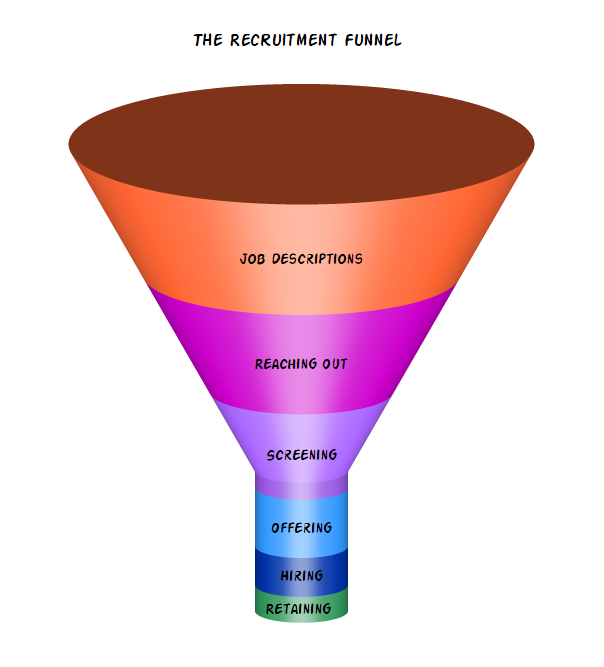Latest news about Bitcoin and all cryptocurrencies. Your daily crypto news habit.
 nd3000/Shutterstock.com
nd3000/Shutterstock.com
It’s a known fact that women are highly underrepresented in the Tech industry.
Some argue that this is a “natural” given fact and there’s virtually nothing that can be done about it, or as I’ve previously heard numerous times: “Women just do not apply… we keep our jobs postings open for all but we only get men’s applications…”.
Well, chances are you’re probably doing it wrong. There isn’t anything “natural” about it. You CAN make a difference just by doing some things differently. Some are easier than others and can be regarded as “quick wins”, while others require deep and profound changes in your company’s culture. I’d like to think of it as a bottom-up/ top-down combined process in order to achieve the best outcomes as quickly as possible.
In this post, I will give practical and scientifically-backed techniques to adjust your recruitment funnel, in order to attract more women to tech positions in your company.
Before I start, It’s important to say that I do not, by any means, mean hiring under-qualified applicants just because they’re women. That’s obviously not the solution I’m suggesting because I think doing that can only make things worse for women. And you know what? That is actually also a myth. No one does that.
So here goes. I have assembled together a list of actions you can actually implement in every step of your recruitment funnel that can substantially increase the number of women in your company.
I’ve gathered this list based upon my academic background as a Social Psychologist, my experience as a Software Engineer for the past 10 years and as a Woman in Tech.
Quick Wins - Edit Your Job Descriptions
Make sure your job descriptions are inclusive to all to get more female applicants. This is how you do it the right way:
- Avoid gender-related superlatives — avoid terms like “Ninja” / “Rockstar” / “Superstar” which usually correspond more with male applicants. Women rarely identify with these words, which will probably make them withdraw from applying.
- Specify your REAL “Must-haves” — Write only your REAL ‘must have’ requirements as must-haves and other criteria as “nice to have”. If you’re saying you’re looking for someone with at least 8 years of experience but you’ll settle with someone who has only 4, don’t write 8 as a minimal requirement. That’s because research has shown that women tend to apply to job descriptions only if they match 100% of the criteria whereas men usually settle for 60%.
- Avoid describing a masculine environment — Women usually favor communication with others and cooperation over aggressiveness and competition. Studies show that using masculine terms which depict a masculine environment lead women to withdraw their application. So, for instance, instead of using terms like “active” / “dominant” / “adventurous”, use words that emphasize a more communal and collaborative environment, like “commit” / “connect” / “cooperate”. Other than that, avoid bragging about your office’s pool tables, free beers flowing, and extensive video games. It may sound inviting to you, but it can also scare some women away since it creates an image of a very masculine workplace. In short, framing is everything. Take for example the case of one college who went from 10% female CS majors to 40% by renaming a course previously called “Introduction to programming in Java” to “Creative approaches to problem solving in science and engineering using Python”.
- Choose your (gender neutral) language carefully — If you’re using a language which is not gender neutral, such as Hebrew, German or French, do not use the masculine form. In Hebrew, for instance, there are 2 different words for a male developer and a female developer. There are a few options to handle this. You can bypass this by adding slashes (he/she) to state that you’re looking for either one. Make your message even clearer by saying you’re looking for a female developer. Then add a disclaimer at the end saying the ad may state you’re looking for a woman applicant but is open for both men and women. From my experience, these kinds of ads usually get more attention from women and they share it with each other on social media because they feel like you’re approaching them specifically.
- Include diverse images — if your job descriptions include images, verify these images are inclusive and include images of women. If they include a large group of people, having only one woman is not enough. Count the men-women ratio in your images. Also, verify that the women in your images are active, upfront and doing the same job as the men (e.g., coding in front of the computer vs. taking notes). Diversity in images should apply also for other underrepresented minorities such as people of color, people with disabilities, different ethnicities, LGBTQ, and various age groups. Take a look at these examples:
Do:
Don’t:
 Matej Kastelic/Shutterstock.com
Matej Kastelic/Shutterstock.com
Reach out - Actively Seek the Underrepresented
Actively and knowingly approach women on linkedIn and other social media. Collaborate with dedicated Women in Tech communities. There are tons of them and many initiatives dealing with these issues. Sponsor such initiatives and send mentors from your company. Ask them to publish your job listings, actively stating you’re looking for more female employees. Ask your recruiters and job hunters to emphasize and prioritize women applicants while scouting for talent. Check out this article by Duolingo who describes how they achieved a 50:50 gender ratio for new software engineer hires by doing all of those.
Adjust Your Screening Methods
- Actively eliminate biases while sorting through resumes — Many studies show that there’s an unconscious bias when screening through resumes. The experimental paradigm is quite common and simple: two groups of people are asked to evaluate exactly identical resumes, only difference being the name of the applicant and nothing more. One study, for instance, has found that just by changing the applicant’s first name from ‘John’ to ‘Jennifer’ has resulted in perceiving Jennifer as under qualified, unworthy, and if given at all, the salary package was $4000 less than John’s! Did I mention that both resumes were exactly the same apart from their names? This is also the case for other underrepresented groups. For example, resumes with White names had a 50% greater chance of receiving a call-back than resumes with Black names, and a 28% greater chance than Asian-sounding names. Since these biases are usually unconscious, the easiest thing you can do in order to cope with them is removing personal information (names, photos, marital status etc.) from candidates’ profiles and resumes. There is even a chrome extension: unbiasify that hides names and profile photos on social networks so you can focus on what actually matters when recruiting.
- Reduce the Stereotype Threat on Job Interviews / Coding Tests - Stereotype threat is a condition in which performance can deteriorate because of concerns about possibly confirming negative stereotypes about one’s social group, and it’s one of the most widely studied topics in the field of Social Psychology. When an individual is reminded of their social group (e.g. their gender), and there’s a negative stereotype about that social group (e.g. women are not expected to be good at STEM fields), performance can be undermined as a result. Most times, this feeling of threat is totally unconscious, but it can definitely affect candidates’ performance. It can be triggered even by the most subtle clues to the stereotype, such as being the only woman in the room, and that alone can hinder performance (and if you think about it, being a woman in tech means constantly experiencing a stereotype threat. But that’s for another blog post). So what can you do? Try to avoid situations in your job interviews that highlight the candidate’s gender, e.g. being interviewed solely by men, or taking a programming test as part of a competition between a group with a large majority of men. Make sure you have enough female interviewers in your pool, and enough women composing and checking the exams used in the hiring process. If you don’t, try to take the applicant for a tour of your office where she will (hopefully) see other women. That way, you can reduce the stereotype threat and eliminate the anxiety.
- Educate Interviewers about the Confidence Gap and Imposter Syndrome — Reshma Saujani, the Founder of Girls Who Code Organization, mentions in her excellent TED talk how the girls who learn to code always tell their teachers they don’t know how to write the code. The teacher will look at her screen and she’ll see a blank text editor. If she presses “UNDO” a few times, she’ll see that her student wrote some code and deleted it completely. It’s always the same story… The student came close, but she thought it wasn’t good enough and decided to delete it altogether. This happens because women tend to underestimate their abilities and performance and to over-judge themselves, regardless of their actual performance, whereas men tend to overestimate their abilities and performance. Studies have labeled this pattern as the “Confidence Gap”. This will lead to asking for less money for the same job and not applying for a job unless you fit 100% of the requirements, as stated above. When taken to the extreme, this may also be the case of the famous “Imposter Syndrome” which is usually more common among women. This phenomenon commonly describes highly achievable women who constantly feel like it’s just a matter of time before everyone will figure out that they’re not as smart or qualified as they think they are and expose them as frauds. Be aware of these phenomena while interviewing women and try to make them feel as comfortable as you can. When you’re interviewing a woman, notice how she describes herself and tells about the stuff she’s done. Women are usually socialized to be modest and not brag about their achievements, as opposed to men. Ask guiding questions to REALLY find out what she knows and what she’s done before. For instance, if she’s describing a project she was part of, and keeps saying “We”, ask her what HER part in it was, exactly! Be patient and kind during the interview. Even if she says she doesn’t know how to answer your question, try to find out more about what she does know. Maybe she knows 90% of the answer but didn’t say anything because she didn’t get it all and was afraid to get it wrong? Perhaps what you consider “good performance” is just OK or not good enough for her? (remember the ‘UNDO’ example from above). Acknowledge what she’s doing right to build-up her confidence and try not to be too judgmental. Once again, I’m not suggesting to lower the bar here, just being a little more aware.
Compare Employment Terms
- Make sure you offer the same terms to all — The gender pay gap for the same type of work, position and working hours is to some extent but not entirely, due to the fact that women usually ask for less. Much less. They’re also less likely to negotiate. So if you decide to hire and make an offer to a new employee, be sure to equally pay her. Even if her salary expectations are lower than what you’d usually pay, give her exactly what you’d give a male employee with the same type of skills and experience. If you’re not sure how much that would be, check your current salary data. Remove the names and cross-reference by years of experience, education, position, and role. Check if your current state already showcases a gender gap and make sure you equally pay for the same positions. Do this comparison every couple of months to make sure there are no gaps, and be public about it.
- Make your workplace accessible to parents — Family-friendly workplaces are more inviting to parents in general, and specifically to moms who often struggle to keep the famous “Work-Life Balance”. Both moms and dads prefer flexibility. Specifically, having flexible working hours and the ability to occasionally work from home can be crucial for young parents. Make sure you give this flexibility and limit the number of meetings and gatherings taking place after 5 P.M. Dads should also be encouraged to maintain a healthy work-life balance and leave early from time to time to pick up their kids, or stay home with them when they’re sick. It will make things better for everyone. More so, companies that offer parental leave to dads as well, (like Facebook which offers 4 months of parental leave to all employees) are making an important statement saying they really care about their employees’ well being. Many companies are starting to follow this policy. Women often feel pressured to step back from the work world when they give birth and if they go on a long leave they often feel like they’re left behind during this time. Treating dads the same way can help them become better fathers and help make sure they have the same starting point. Meaning, you’re not only making your workplace more desirable and welcoming to parents in general, you’re also eliminating possible hiring biases regarding a candidate’s family/marital status.
One Final Advice
You can start implementing all or some of those things today and test your results afterward. Carefully track the numbers before and after you introduce these changes (or a part of them).
One way to track your process, is to make sure that the percentage of women is maintained throughout the entire recruitment funnel. If at some point the ratio is dropping, it probably means that there’s a problem at that specific phase.
Define realistic goals with measurable KPIs to see how well you’ve done. If your company is big, and you change the ratio by only 1%, it can still be a very big change. Celebrate that! And let me know how it goes :) Would love to hear some follow-ups.
All that being said, you can also attract more women by changing your company culture. A non-inclusive company will not succeed in retaining female talents. In my next post in this series, I will discuss how you can make your workplace more inclusive for women, and retain the women you’ve actually recruited, so stay tuned!
How to Attract More Women (and not the way you think) was originally published in Hacker Noon on Medium, where people are continuing the conversation by highlighting and responding to this story.
Disclaimer
The views and opinions expressed in this article are solely those of the authors and do not reflect the views of Bitcoin Insider. Every investment and trading move involves risk - this is especially true for cryptocurrencies given their volatility. We strongly advise our readers to conduct their own research when making a decision.


